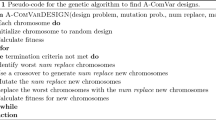Abstract
We derive theD- andG-efficiencies of product designs in a multifactor experiment in terms of theD- andG-efficiencies of the designs in the marginal models.
Similar content being viewed by others
References
Clark V (1965) Choice of levels in polynomial regression with one or two variables. Technometrics 7:325–333
Cook RD, Thibodeau LA (1980) Marginally restrictedD-optimal designs. J Amer Statist Assoc 75:366–371
Dette H, Wong WK (1995) OnG-efficiency calculation for polynomial models. Ann Statist 23:2081–2101
Draper NR, Gaffke N, Pukelsheim F (1991) First and second order rotatability of experimental designs, moment matrices, and information surfaces. Metrika 38:129–161
Draper NR, Pukelsheim F (1994) On third order rotatability. Metrika 41:137–161
Fedorov VV (1972) Theory of optimal experiments. Academic Press, New York
Lau TS (1988)D-optimal designs on the unitq-Ball. J Statist Plann Inference 19:299–315
Lim YB, Studden WJ (1988) EfficientD s -optimal designs for multivariate polynomial regression on theq-cube. Ann Statist 16:1225–1240
Rafajłowicz E, Myszka W (1988) Optimum experimental design for a regression on a hypercube — generalization of Hoel’s result. Ann Inst Statist Math 40:821–827
Schwabe R, Wierich W (1995)D-optimal designs of experiments with non-interacting factors. J Statist Plann Inference 44:371–384
Schwabe R (1995) Experimental design for linear models with higher interaction terms. In: Mammitzsch V, Schneeweiß H (eds) Symposia Gaussiana. Proc. 2nd Gauss Symposium, München 1993. Conf. B: Statistical Sciences. DeGruyter, Berlin, 281–288
Schwabe R (1996a) Optimal designs for additive linear models. Statistics 27:267–278
Schwabe R (1996b) Optimum designs for multi-factor models. Lectures Notes in Statistics 113. Springer, New York
Wong WK (1994) Multi-factorG-optimal designs with heteroscedastic errors. J Statist Plann Inference 40:127–133
Author information
Authors and Affiliations
Additional information
Work supported by grants Ku 719/2 and 477/645/96 of the Deutsche Forschungsgemeinschaft
Rights and permissions
About this article
Cite this article
Schwabe, R., Wong, W.K. A relationship between efficiencies of marginal designs and the product design. Metrika 45, 253–257 (1997). https://doi.org/10.1007/BF02717107
Received:
Issue Date:
DOI: https://doi.org/10.1007/BF02717107




